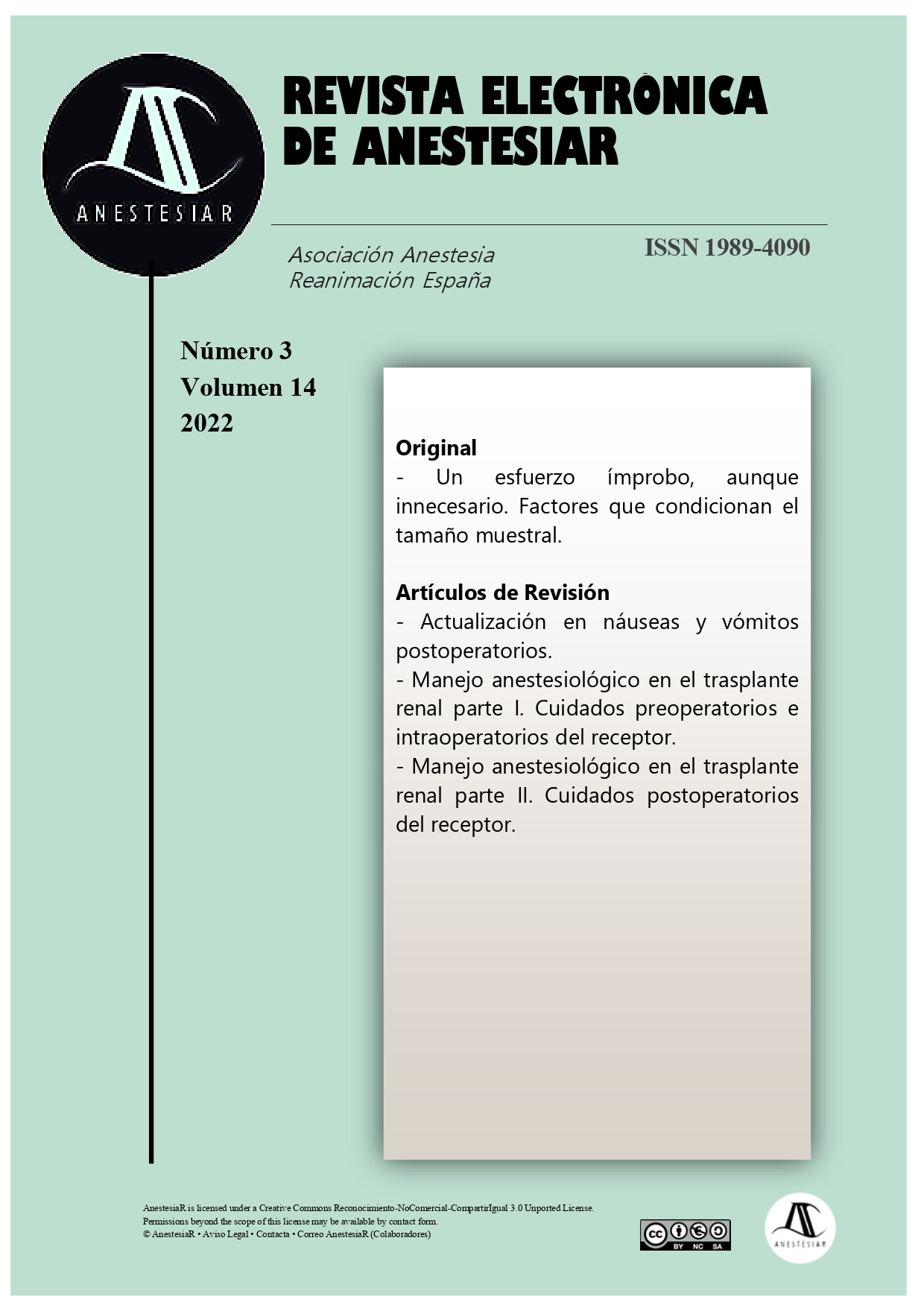Anesthesiological management in renal transplantation Part II. Receptor postoperative care.
DOI:
https://doi.org/10.30445/rear.v14i3.994Keywords:
Renal transplantation, Kidney transplantation, Postoperative care, Postoperative management, Organ solid receptor, Intensive care, AnesthesiaAbstract
Postoperative care of renal transplant recipient should be done in Intensive Care Units or specialized units. Immediate postoperative goals are to ensure hemodynamic stability in order to preserve perfusion and optimize graft function, reverse hypothermia, monitor fluid therapy, manage postoperative pain, and adjust immunosuppressive therapy. Urinary output monitoring during the immediate postoperative period is essential, since the immediate start of urine production is a predictor of a good prognosis for the graft and the patient.
Graft function in the immediate postoperative period is influenced by a combination of donor, recipient, and intraoperative factors. Surgical complications development appears to decrease graft survival, so diagnosis and treatment it early are important. The objective of the present review is to describe the most important aspects of management within the immediate postoperative period of renal transplantation.
References
Rivera Luna EN, Cruz Santiago J, Meza Jiménez G, Bernáldez Gómez G, Moreno Ley PI. Manejo perioperatorio en el receptor de trasplante renal. Hospital de Especialidades Centro Médico Nacional «La Raza» IMSS. Rev Mex Traspl. 2016; 5(1): 27-33.
Uptodate. Hendrikus JM Lemmens. Anesthesia for kidney transplantation [sede Web]. 2020. UpToDate, Waltham, MA.
Roldán Reina AJ, Egea Guerrero JJ, Palomo López N, Cuenca Apolo DX, Adriaensens Pérez M, Martín Villén L. Postoperatorio de trasplante renal en unidad de cuidados intensivos: evaluación del injerto mediante técnicas de imagen. Medicina Intensiva. 2019; 43(6): 384-386.
Haberal M, Boyvat F, Akdur A, Kırnap M, Özçelik Ü, Yarbuğ Karakayalı F. Surgical Complications After Kidney Transplantation. Exp Clin Transplant. 2016; 14(6): 587-595.
Steadman RH, Wray CL. Anestesia para el trasplante de órganos abdominales. En: Miller RD, Cohen NH, Eriksson LI, Fleisher LA, Wiener-Kronish, Young WL. Miller Anestesia. 8a edición. Madrid: Elsevier; 2015. 2262-2291.
Cofan F, Torregrosa JV. Manejo clínico del paciente trasplantado renal de donante vivo. Arch Esp Urol. 2005; 58(6): 531-536.
Mittel AM, Wagener G. Anesthesia for Kidney and Pancreas Transplantation. Anesthesiol Clin. 2017; 35(3): 439-452.
Tocancipá DR, Tejada Perdomo JH, Medina Herrea A, et al. Complicaciones anestésicas en trasplante renal. Rev Col Anest. 2011; 39(1): 30-37.
Hadimioglu N, Saadawy I, Saglam T, et al. The effect of different crystalloid solutions on acid-base balance and early kidney function after kidney transplantation. Anesth Analg. 2008; 107(1): 264-9.
Cavaleri M, Veroux M, Palermo F, Vasile F, Mineri M, Palumbo J, et al. Perioperative Goal-Directed Therapy during Kidney Transplantation: An Impact Evaluation on the Major Postoperative Complications. J Clin Med. 2019;8 (1): 80.
Covarrubias Gómez A. Manejo del dolor postoperatorio en el enfermo con trasplante renal. Rev Mex Anest. 2009; 32(1): 148-153.
Kar SK, Khurna HS, Ganguly T. Anesthesia management of renal transplantation: an update. Anaesth Pain & Intensive Care. 2018; 22(3): 383-390.
Cortázar Benítez LF, González Patiño MA, Barbosa Zamora A, Pardinas Llergo MJ, Rodríguez Weber F, et al. Infecciones tempranas postrasplante renal. Med Int Mex. 2018; 31(5): 559-566.
Garg N, Jorgenson M, Descourouez J, Saddler CM, Parajuli S, Astor BC, et al. Pneumocystis jiroveci pneumonia in kidney and simultaneous pancreas kidney transplant recipients in the present era of routine post-transplant prophylaxis: risk factors and outcomes. BMC Nephrol. 2018; 19(1): 332.
Oppenheimer F, Pascual J, Pallardó L. Inmunosupresión en el trasplante renal. En: Lorenzo V, López Gómez JM (Eds). Nefrología al día. Inmunosupresión en el trasplante renal. Disponible en: https://www.nefrologiaaldia.org/241. Consultado 16 Dec 2020.
Quicios Dorado C, Burgos Revilla FJ, Pascual Santos J, Marcén Letosa R, Gómez García I, García Navas R, et al. Inmunosupresión y complicaciones quirúrgicas post-trasplante renal. Arc Esp Urol. 2006; 59(7): 697-705.
Pérez Tamajon L. Complicaciones médicas precoces en el trasplante renal. En: Lorenzo V, López Gómez JM (Eds). Nefrología al día. Complicaciones médicas precoces tras el trasplante renal. Disponible en: https://www.nefrologiaaldia.org/140. Consultado 09 Dec 2020.
Moreso F, Alegre R, Ariceta G, Beneyto I, Bernis C, Calvo N, et al. Tratamiento de la anemia postrasplante renal. Nefrología Sup Ext. 2011; 2(2): 16-24.
Garay Padrón RA, López Romero J, Cruz Abascal RE, Pérez de Armas RA, Hernández Hernández PE, López Soler JC. Complicaciones médicas en el trasplante renal inmediato. Medicentro. 2004; 8(2).
Barba Abad J, Rincón Mayans A, Tolosa Eizaguirre E, Romero Vargas L, Rosell Costa D, Robles García JE, et al. Complicaciones quirúrgicas en el trasplante renal y su influencia en la supervivencia del injerto. Actas Urol Esp. 2010; 34(3), 266-273.
Downloads
Published
How to Cite
Issue
Section
License
Copyright (c) 2022 Revista Electrónica AnestesiaR

This work is licensed under a Creative Commons Attribution-ShareAlike 4.0 International License.
 Envío y derechos de autor
Envío y derechos de autor


 Revista Electrónica AnestesiaR by
Revista Electrónica AnestesiaR by 